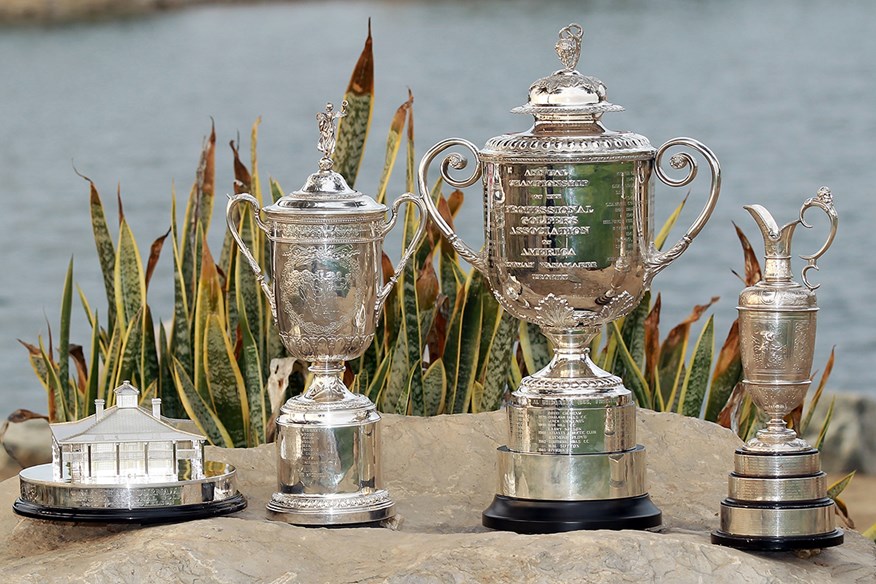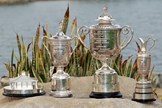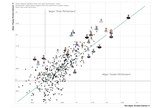Who will win this year’s majors? We’ve found a hidden stat to help you work it out
Published:
If you fancy a (responsible) flutter on golf majors this season, be sure to factor this lesser-known stat into your deliberations.
Finding value in golf betting markets can be as elusive as searching for the ball you’ve just sliced into the rough on the first hole for the sixth round in a row.
It’s there somewhere, just not where you’re looking.
Conventional thinking would suggest studying player form, how their game fares on particular course types, previous results at the tournament, competence in challenging conditions, and a host of other logical factors indicating which tour pros could go low.
The trouble is, all these tangibles are also built into the algorithms that price up the sportsbook, with a healthy ‘over-round’ lumped on top to ensure the bookmaker returns a profit over time.
There’s a reason 50/50s in sports markets aren’t priced at Evens (+100).
So where do you find your edge?
Well, there’s always good old-fashioned hunch – we have plenty here at Today’s Golfer – although we strongly suggest you don’t blindly follow our questionable instincts!

You have to dive a bit deeper into the stats behind the scorecards.
It’s here you’ll come across a plethora of Strokes Gained (SG) data, conceived and continually refined to provide a measure of how much better or worse a tour pro performs in specific areas of the game compared to their counterparts.
In the same way that we accept the end-of-year world rankings to fairly reflect ‘what’ happened in the preceding 12 months of competition, the vast data underpinning end-of-season SG leaderboards is now widely accepted as a logical explanation of ‘how’ it happened too.
And unsurprisingly, the last 24 months have Scottie Scheffler plastered across the majority of them. It’s why the World No.1 is typically priced no higher than 5/1 (+500) going into a tournament of note. Perhaps Scottie will be more competitively priced in 2025 with McIlroy getting off to a fast start and Xander Schaufelle now a proven winner on the biggest stages.
It’s not a hugely exciting price to get behind, however, particularly given the right player, on the right day, on the right course has a puncher’s chance of winning on tour. The 64 different winners across 92 PGA and DP World Tour tournaments last year illustrate this point as well as any.
The average closing price of a top-5 finisher at major championships and PGA Tour Signature Events in 2025 was a massive 75/1 (+7500), with the winner’s price before the off dragged down to around 35/1 (+3500), thanks to Scheffler’s relentlessness.
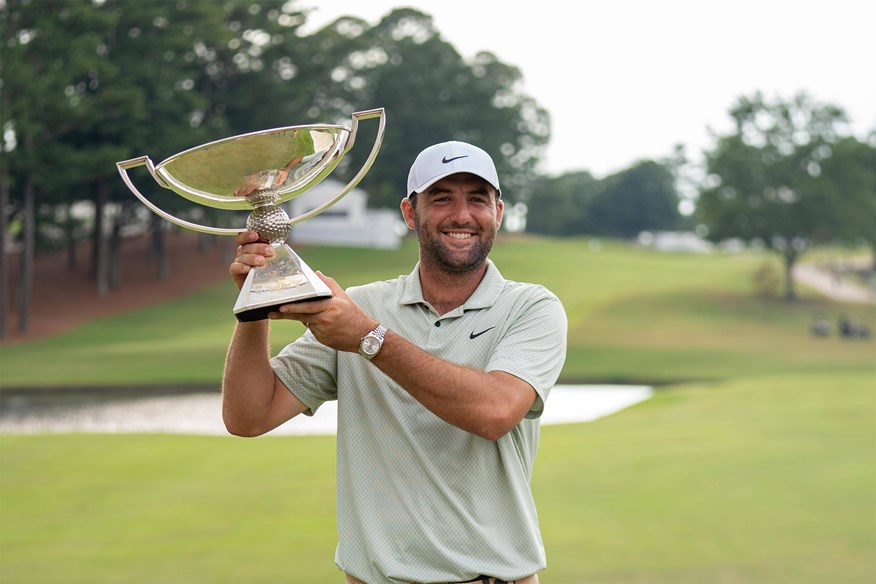
And since it’s not uncommon for bookmakers to now offer each-way payouts on up to 12 places at majors, an opportunity emerges for some calculated trades on less fancied players whose higher prices underestimate how well their game stacks up against the other 150-odd tour pros in a given week.
You only need to go 20 places deep into the pre-tournament price list before you hit odds of 50/1 (+5000), and before you know it you’re into the 100s, trying to decide whether Justin Rose at 150/1 (+15000) or Max Homa at 125/1 (+125000) is better value.
Even after doing your homework and having dived into the strengths and weaknesses of each player, you can be left none the wiser. So what’s the solution?
Yep, you guessed it, even more golf statistics you never knew you needed!
Introducing ‘True SG’, peeling back the raw data a further layer to more accurately account for the relative strength of the fields they compete in.
With the introduction of limited-field Signature events on the PGA Tour with their bumper prize funds, it has never been more true that better players are choosing to play more difficult schedules, against stronger opposition and on tougher courses than they once might have. Conversely, lower-ranked tour pros who are struggling to keep their cards rely on picking up points in the FedExCup Fall, and more opposite-field events which invariably are against lower-quality opposition.
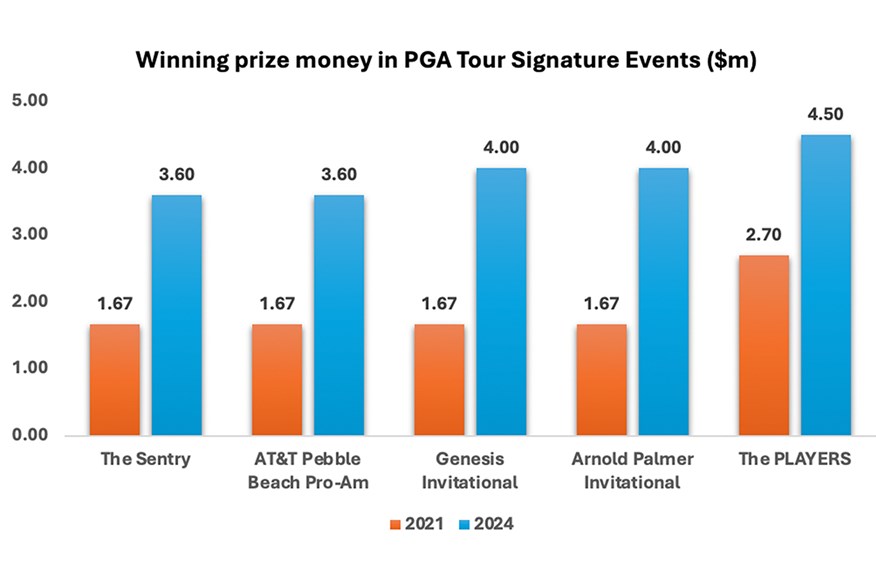
A player’s schedule will therefore influence their positioning on the PGA Tour’s SG leaderboards come the season end as much as their actual performance.
A case in point highlighted by devising statisticians DataGolf was the head-to-head comparison of tour pros Viktor Hovland and Patrick Fishburn, who despite both being full-time PGA Tour members in 2024, didn’t compete in a single event together. Hovland finished the season ranked 50th for raw SG (+0.56), whereas Fishburn ranked 26th (+0.76) for players who completed at least 35 rounds.
Now, to the PGA Tour’s non-initiated, it would be reasonable to assume Fishburn played the better golf in 2024. That is until we factor in that Hovland competed against fields that were, on average, more than a shot better than Fishburn’s opposition. In fact, nobody played a stronger schedule than Hovland last year. A true SG measure would have ranked Hovland 19th for the season (+1.2) and Fishburn 78th (+0.32).
While this was the most extreme example of raw versus true SG discrepancy on tour last season, it helps us to understand why inequality in players’ schedule strengths is widening. The PGA Tour is currently at an all-time high for the differential between a player’s season-long raw and true SG performance (+0.30), with the tour’s limited-field Signature events undoubtedly driving that gap.
True SG quantifies a player’s potential to find their best golf when it matters most. It’s another way of considering who punches above their weight and vice-versa as illustrated by this graphic that highlights historic over and under-performers in majors. Note that the GOAT, despite his major prowess, didn’t discriminate when it came to lower-profile events. Winning was simply a habit in his pomp.
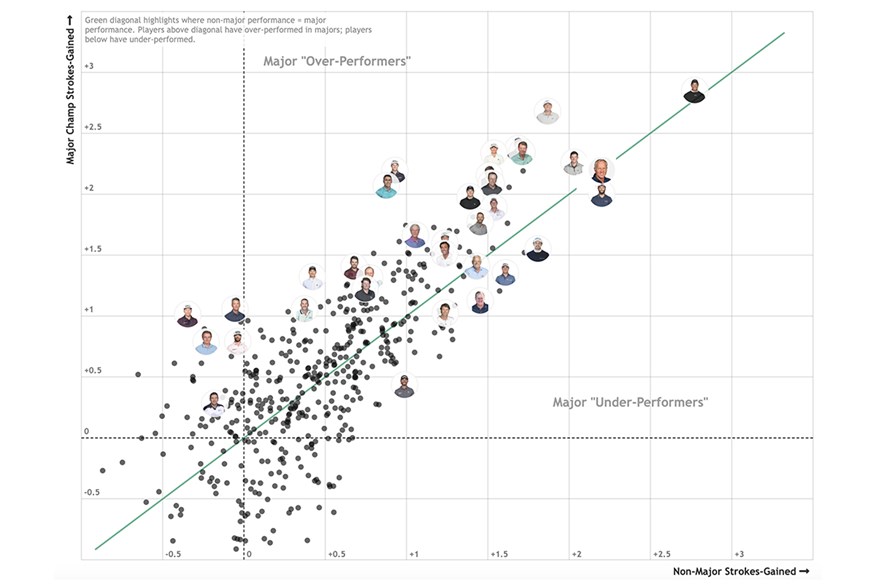
So, if you’re still with me, I’ll tell you why the moral behind the maths may be worth bearing in mind when picking out your golf major winners this year.
Let’s consider Scottie Scheffler’s well-documented putting frailties.
“If he putts awful, then he finishes in top 10. If he putts decent, he wins. He putts great, he runs away,” to quote Tiger Woods’ assessment of Scheffler’s up-and-down relationship with the flatstick.
When taking into account the strength of the field, Scottie’s SG: Putting bumps up 23 places in the rankings to 68th. And by Tiger’s logic, that’s probably the difference between him winning and finishing in the chasing pack, given his dominance from tee to green.
Across all facets of the game, you’ll find notable raw versus true SG differentials, that when married up with the unique demands of each course, might give you an objective reason to believe there is more value than their price suggests.
Remember, you’re not looking for a winner necessarily, just a player who has the attributes to go well on a particular track, and if those attributes shine brightest on the biggest stages, then perhaps there is an edge to be had.
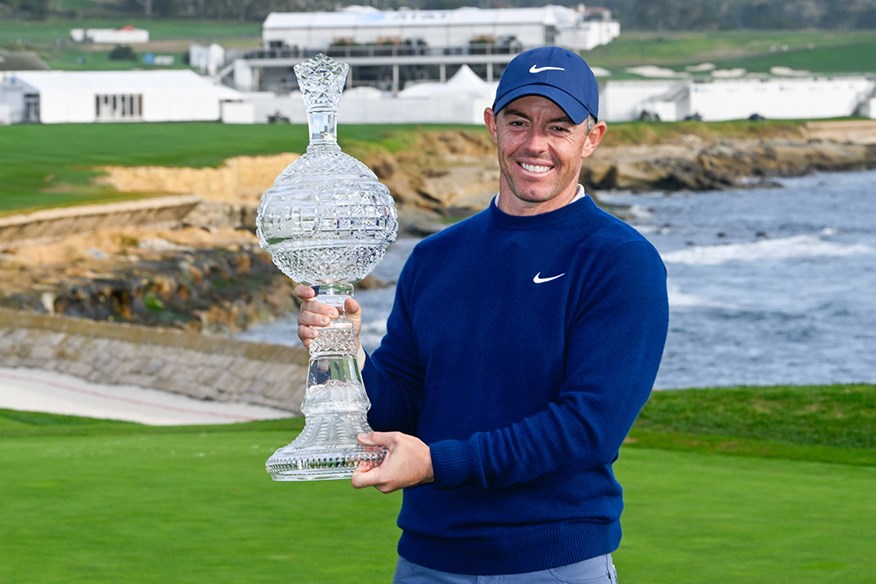
For example, The Open Championship heads back to Royal Portrush in 2025, where inaccuracy Off-the-Tee is penalized more severely compared to some Links on the Open roster. Russell Henley (82 raw vs 46 true), Justin Thomas (81 vs 50), and Matt Fitzpatrick (91 vs 64) are a few players who have raised their OTT performance considerably in stronger fields.
Oakmont Country Club hosts the US Open in what will likely be the toughest test of the season, given its scoring average of +3.56 in 2016. As was the case at Pinehurst No.2, finding the green isn’t always good enough. “There are some places that nobody can putt from, regardless of how good you are,” the members say.
It’s why plumping for players with strong approach games would seem a sensible tactic to maximize value, particularly those with positive discrepancies such as Rory McIlroy (75 raw vs 35 true), Patrick Cantlay (95 vs 47), and Tommy Fleetwood (90 vs 46), who coincidently finished second, T3, and T16 at Pinehurst.
And as for Augusta…well, you can’t afford to have any chinks in the armor. Scheffler tidied up his performances on the greens to rank 22nd and 16th for his 2024 and 2022 victories, far exceeding his raw SG: Putting rank of 91st on tour.
Big movers on the true SG: Total leaderboard include Cam Davis (156 raw vs 98 true), Matthieu Pavon (102 vs 49), Chris Kirk (97 vs 48), and Will Zalatoris (95 vs 52). Strangely enough, all four registered top-16 finishes at the season’s first major. Got you thinking?
As with all betting strategies though, there are no silver bullets, and you should only risk what you can afford to lose. True SG data, however, would seem a worthwhile metric to filter down your shortlist for this year’s major winners, after you’ve taken into account all the tried and tested player-course history factors, and of course – your gut!
For those interested in exploring ranking discrepancies further, true SG data can be accessed via the DataGolf website.
